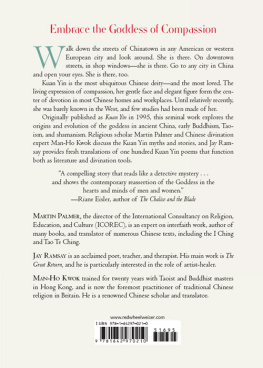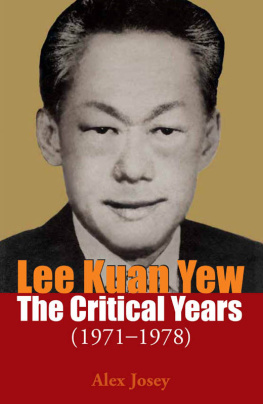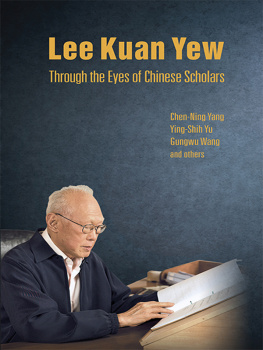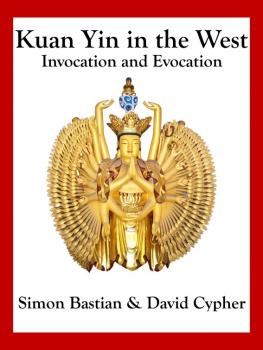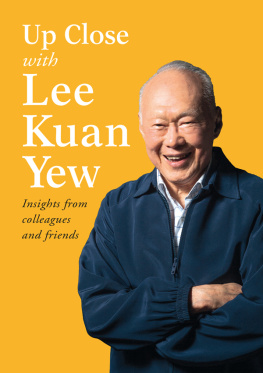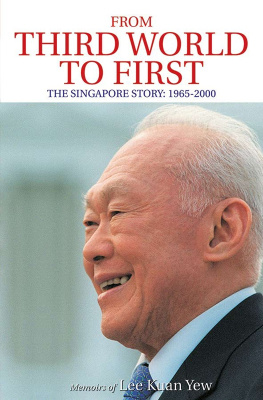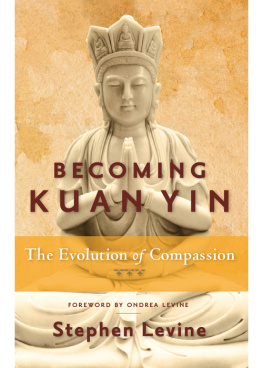Martin Palmer - The Promise of Kuan Yin
Here you can read online Martin Palmer - The Promise of Kuan Yin full text of the book (entire story) in english for free. Download pdf and epub, get meaning, cover and reviews about this ebook. publisher: Hampton Roads Publishing, genre: Religion. Description of the work, (preface) as well as reviews are available. Best literature library LitArk.com created for fans of good reading and offers a wide selection of genres:
Romance novel
Science fiction
Adventure
Detective
Science
History
Home and family
Prose
Art
Politics
Computer
Non-fiction
Religion
Business
Children
Humor
Choose a favorite category and find really read worthwhile books. Enjoy immersion in the world of imagination, feel the emotions of the characters or learn something new for yourself, make an fascinating discovery.
- Book:The Promise of Kuan Yin
- Author:
- Publisher:Hampton Roads Publishing
- Genre:
- Rating:5 / 5
- Favourites:Add to favourites
- Your mark:
- 100
- 1
- 2
- 3
- 4
- 5
The Promise of Kuan Yin: summary, description and annotation
We offer to read an annotation, description, summary or preface (depends on what the author of the book "The Promise of Kuan Yin" wrote himself). If you haven't found the necessary information about the book — write in the comments, we will try to find it.
The Promise of Kuan Yin — read online for free the complete book (whole text) full work
Below is the text of the book, divided by pages. System saving the place of the last page read, allows you to conveniently read the book "The Promise of Kuan Yin" online for free, without having to search again every time where you left off. Put a bookmark, and you can go to the page where you finished reading at any time.
Font size:
Interval:
Bookmark:
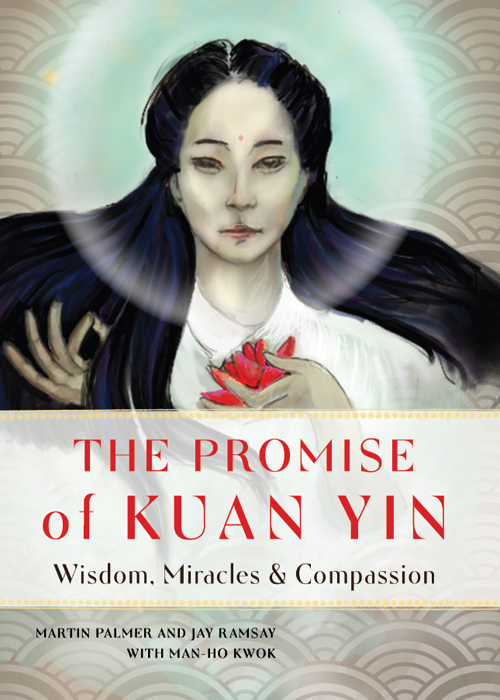
Martin Palmer, Jay Ramsay
with Man-Ho Kwok

Copyright 1995, 2009, 2021
by Martin Palmer and Jay Ramsay with Man-Ho Kwok
All rights reserved. No part of this publication may be reproduced or transmitted in any form or by any means, electronic or mechanical, including photocopying, recording, or by any information storage and retrieval system, without permission in writing from Red Wheel/Weiser, LLC. Reviewers may quote brief passages. Originally published as Kuan Yin: Myths and Revelations of the Chinese Goddess of Compassion by Thorsons, an Imprint of HarperCollins Publishers, copyright ICOREC 1995 and in 2009 as The Kuan Yin Chronicles by Hampton Roads Publishing, ISBN: 978-1-57174-608-5.
Cover design by Kathryn Sky-Peck
Cover photograph Hampton Roads Publishing
Interior by Deborah Dutton
Typeset in Centaur MT Std and Vincenza Display
Hampton Roads Publishing Company, Inc.
Charlottesville, VA 22906
Distributed by Red Wheel/Weiser, LLC
www.redwheelweiser.com
Sign up for our newsletter and special offers by going to www.redwheelweiser.com/newsletter
ISBN: 978-1-64297-021-0
Library of Congress Cataloging-in-Publication Data available upon request.
Printed in Canada
MAR
10 9 8 7 6 5 4 3 2 1
for Lucy Lidell, true healer, tantrika,
teacher, and friend
It is finished in beauty.
It is finished in beauty.
for Eli, whose book this is.
From Martin's side: special thanks to Shoji Hazama for hours of patient travel and answering questions; to colleagues in China, especially Peter Zhao; to my long-suffering colleagues in ICOREC; and, finally, reverence and love to the Goddess, even though she is not mine.
From Jay's side: special thanks to Carole for her guidance, Lucy as ever, Alan Rycroft, Gabriel Bradford Millar, Scarlett Laroma, Jonathan Mallard, Henry Shukman, Rae Bethand the Goddess Herself.
Finally, warm thanks to Elizabeth Hutchins for her editorial expertise.
It is unwise to always follow your own mind,
It sounds like a dragon's drone or a tiger's laugh
Look up at Heaven nowit has a Milky Way of stars....
I tell you recognition and awareness will come in time.
This strange poem, number 53 of the one hundred divination poems of Kuan Yin, is known as Kuan Yin's Promise. In its mystical language and imagery, it hints at other worlds, other realities, and at the limits of human understanding alone. It also holds out the promise, Kuan Yin's promise, of being able to be in touch with wisdom, insights, and understanding which are far greater than that which any one human being can create. It offers the promise of help from beyond this world, from Heaven itself.
And it is this that underlies the huge popularity of Kuan Yin, the Goddess of CompassionChina's most beloved deity. Through her, we can be in touch with divine wisdom, feminine divine wisdom that can help us to live more fully, wisely, and thoughtfully. Through her also, we can be rescued from the cycles of birth, death, and rebirth and carried over the oceans of suffering and rebirth to land safely in the Pure Land of happiness and peace.
It is this fusion of promises that has caused Kuan Yin to be precious to untold millions in China for more than a thousand years. This book takes you on a series of journeys: through history, through mythology, through stories, and finally through Kuan Yin's magical poems to discover the heart of her compassion which has offered hope to so many for so long.
What is it about Kuan Yin that creates such fascination, such devotion, and such interest? Her image is to be seen everywhere in the Chinese world. Be it as a twelve-meter high wooden statue in Quanzhou, Fujian Province; as the presiding statue outside the new maternity hospital in Guangzhou, Guangdong Province; as a tiny charm hanging from the rearview mirror of a taxi, or as the much loved statue in a home shrine. There is no other deity in China who is so adored, so worshipped, or from whom so much is hoped. The main reason for this appeal is her accessibility. Kuan Shi Yin, to give her her full titlethe One Who Hears the Cries of the Worldis so named because she is the one to whom anyone can turn for help. Her origins lie in one of the most beautiful of sacred books, the almost two-thousand-year-old Lotus Sutra. There the vow that Kuan Yin has taken is set forth, and at its heart is compassion for all who suffer. She is described as Wisdom's sun, as Illuminator of the world, and as Compassion wondrous as a great cloud. As such, she is unusual in the religious worlds of China. The majority of deitiesBuddhist, Daoist, shamanic, and even Confucianare stern figures or unreliable tricksters. They are prayed to in order to prevent them causing trouble. While there are a fewsuch as the Immortal Ti Kuai Li, who fights to defend the poor, or Immortal Lu Tung Ping, who uses his medicinal skills to help heal the sickmost Chinese deities are far from compassionate or caring.
Put alongside this the fact that there are few goddesses in Chinese religion, and the need for and role of a compassionate goddess is clear. This becomes even more so when one considers the traditional subjugation of women within Confucian Chinese society. The role of the woman was to bear the next male heir to the family name. Thus a compassionate goddess, who was also associated with the gift of children and known for helping people out of dangerous and frightening situations, is going to have an enormous appear, which she does to this day.
Part of the fascination with her is that she changed sex. It is a fascinating story which we explore in detail in chapter 1, for Kuan Shi Yin first arrived in China sometime between AD 200 and AD 400 as Avalokitesvara, a Buddhist male bodhisattva. Bodhisattvas are those who, through countless lives of virtue, have accrued so much merit that they could enter Nirvana. However they decide not to but instead to use their vast store of merit to help suffering beings escape the wheel of reincarnation. Avalokitesvara is one of the most famous bodhisattvas and became a favorite amongst Buddhists in China from the sixth century AD onward, known by his Chinese name Kuan Shi Yina translation of the original Sanskrit name Avalokitesvara.
Sometime around the end of the Tang dynasty (early tenth century AD), Kuan Yin changed sex and became a womanthe form in which she is revered and venerated to this day. We explore how and why and through that exploration encounter the pluralism and diversity of China's religious history.
The religious pluralism of Kuan Yin is of course one of her major features, and we have now discovered that although she arrives as a Buddhist male deity, she has by the twelfth century become an official Chinese Imperial and Daoist deity. While visiting the White Cloud Temple in Beijing, the headquarters of Daoism in China, I noticed a temple dedicated to Kuan Yin but with a title which was unknown to me. It appears that in the year 1119 AD, the Emperor Huizong decreed that Kuan Yin was now appointed as the Goddess Chang Pudu Yuantong Zizaithe goddess whose raft of salvation will carry you to safety. As such, she has her place within the great semi-imperial Daoist temple and headquarters of the China Daoist Association, and also appears at major pilgrimage centers such as Mao Shan near Nanjing, one of Daoism's most sacred mountains. In one of his roles, the Emperor could appoint people to heavenly positions, and he was simply confirming what was already happening amongst the population at large. The male Buddhist bodhisattva had become a Chinese folk religion/Daoist goddess.
Next pageFont size:
Interval:
Bookmark:
Similar books «The Promise of Kuan Yin»
Look at similar books to The Promise of Kuan Yin. We have selected literature similar in name and meaning in the hope of providing readers with more options to find new, interesting, not yet read works.
Discussion, reviews of the book The Promise of Kuan Yin and just readers' own opinions. Leave your comments, write what you think about the work, its meaning or the main characters. Specify what exactly you liked and what you didn't like, and why you think so.

